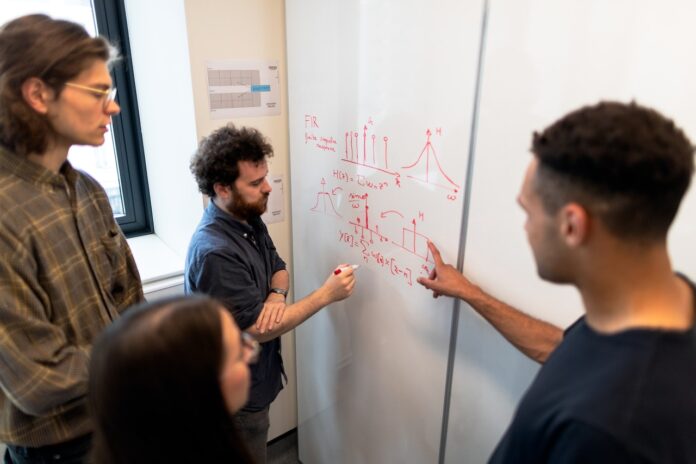Brainstorming is an essential part of the creative process. To kickstart any new endeavour and to get the best ideas, you need a quality brainstorming session as a first step. Ideas get thrown around, creative juices are bubbling, and unorthodox methods spur to life. Anything goes when it comes to breaking new ground, and the point of a good brainstorming session is to shake up the stale method and re-invent the wheel. But how can you get everyone on the same page? Not all employees have the same cognitive process, but everyone needs to be on the same train. It’s easier than you think, and here we go with some concrete ideas!
1. Safe and creative environment
There are no bad ideas during a brainstorming session. Anything goes, all suggestions are equal, and you should nurture any line of thinking. Saying anyone’s idea is wrong will completely shut down that person, put him in a negative light and change his way of thinking. When people can freely express solutions, their brains are open to churning out anything they can think of.
One “No” can put a roadblock to the entire process and create a negative environment. Brainstorms are here to produce as many ideas as possible. The concept of good or bad does not exist at this point in the creative process. A nurturing work environment produces the best platform for the seeds of innovation to blossom.
2. Short and sweet
“Today we will gather for one hour to brainstorm ideas about X”. There you go, that’s all the info your potential invites the need for your session. Setting a timeframe will let people focus and channel their energy efficiently. Our brains work better with a time limit in place, as people can focus and squeeze their brain juices to the maximum.
Sweet aspect comes in the form of rewards, encouragement and a positive attitude. With such nourishment, you will make everyone’s time worthwhile, and people will flock to team brainstorming meetings every time. Remember, you don’t need to have and cram everything into a single brainstorming meeting. Two or three do the trick just fine.
3. The problem should be clear at all times
It’s easy to get lost in the hectic mania of a brainstorming frenzy. Papers are everywhere, there’s lots of talking going around, people are walking everywhere, and info gets lost. This can get exponentially harder to track when there are no limits in place, as good brainstorming practice, and when you wish to get the maximum out of each person. When ideas flow, the stream of creative energy is wild and can get you lost. Drifting away from the subject diminishes the positive aspect of brainstorming and to avoid it, write everything down on a glass writing whiteboard.
The difference between science and goofing around is writing everything on paper. Short notes, essential words and key points are enough. Don’t stop and interrupt people so that you can write all the lengthy sentences down. Writing on the whiteboard is secondary, as you need to keep the conversation going. Let everything talk and jot down the essentials. The keynote and the topic of the brainstorming should be plastered and highlighted on the whiteboard at all times.

4. Lay the foundations
Letting people prepare for a meeting is half the battle. When you buy a new fish, you don’t just dump it into the aquarium, but let the bag soak into the water for a while until your fish gets accustomed. The same principle applies to your brainstorming participants. Inform them beforehand of what the topic of brainstorming will be. You can share some info, pamphlets and guidelines with them and steer them towards the future topic.
The key to success here lies in not restricting your participants too much, as you want them to think creatively once the session comes. Preparation should be general and open, with minimal restraints and guidelines. The resources you provide intend to lay the foundation and nourish any ideas that may spur during the preparation process.
5. Exercise some control
So far, we’ve established that brainstorming sessions function best when there is little to nothing in their way. This is still true, but we want to add one additional factor. As we’ve mentioned above, sometimes the conversation tends to drift off and stray from the topic. It’s your job as the organiser to steer it right back onto it and keep that stream of ideas flowing in the desired direction.
Some people don’t have problems speaking up, individually or in front of a crowd, but they can inadvertently prevent others from exposing themselves. Keep a vigilant eye on who’s talking a lot and who is being silent, and try to give everyone a chance in the spotlight.
6. Follow up
People took time off to attend the brainstorming session, there was a lot of creative energy flowing and work done. With those factors and resources in place, it’s your job to let everyone know of the output. Was it good or bad, or will there be another brainstorming session? Any results and progress made need to find its way back to participants, so people know their contribution was worthwhile.
One follow-up can be a gust of wind in everyone’s sails, after which you will see people lining up to attend. Having an active feedback session will let every participant know that their presence was acknowledged and worthwhile, motivating participants to give their maximum each time.
Brainstorming sessions are a great tool when you wish to break new ground and shake up the stale working process. They offer each individual a chance to shine in a safe and nurturing environment. Some people need a creative outlet to let their suggestions and way of thinking shine. Brainstorms are ideal for such employees, and companies can reap the rewards of unorthodox and creative thinking.
The wildest of ideas can sometimes be the key to success. Without brainstorms, they would forever be locked up in someone’s mind, without a chance to shine and for the entire world to see. It’s up to you to make that magic happen!

